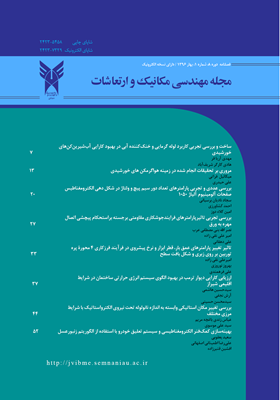بهینه سازی کمک فنر الکترومغناطیسی و سیستم تعلیق خودرو با استفاده از الگوریتم زنبورعسل
محورهای موضوعی : بهینه سازی
سعید یعقوبی
1
![]() ,
علی رضا اطمینانی اصفهانی
2
,
افشین قنبرزاده
3
,
علی رضا اطمینانی اصفهانی
2
,
افشین قنبرزاده
3
1 - مدرس دانشگاه
2 - مهندس شرکت فولاد
3 - عضو هیات علمی گروه مکانیک دانشگاه شهید چمران اهواز
کلید واژه: سیستم تعلیق, کمک فنر الکترومغناطیسی, الگوریتم زنبورعسل, بهینه سازی,
چکیده مقاله :
در این تحقیق، کمک فنر الکترومغناطیسی به مدل یک چهارم خودرو با دو درجه آزادی و مدل یک دوم خودرو با چهار درجه آزادی اضافه شده است. در ادامه، با استفاده از الگوریتم بهینهسازی زنبورعسل در دو مرحله، مدل شبیه سازی شده، بهینه شده است. در مرحله اول، فقط ثوابت کمک فنر الکترومغناطیسی بهینه شده و پارامترهای سیستم تعلیق ثابت فرض گردیده است. در مرحله دوم، علاوه بر ثوابت کمک فنر الکترومغناطیسی، پارامترهای سیستم تعلیق نیز مورد بهینه سازی قرار گرفته که در هر دو مرحله، مقادیر پارامترهای بهینه شده از اعمال ورودی ترکیبی شامل ده ورودی سینوسی با دامنه های مختلف و یک ورودی پله واحد به دست آمده و در نهایت با استفاده از این مقادیر، میزان انتگرال قدر مطلق خطا نسبت به چند حالت ورودی محاسبه شده است. برای تعیین تابع هدف در بهینه سازی انجام شده از انتگرال قدر مطلق خطا استفاده شده که هدف، کمینه سازی سطح زیر نمودار (جابه جایی خودرو) می باشد. نتایج نشان داد که مقادیر تابع هدف در حالت دوم بهینه سازی نسبت به حالت اول کمتر بوده، به گونه ای که به عنوان نمونه در اثر اعمال ورودی سینوسی با دامنه 5 مقدار این تابع برای مدل یک چهارم و یک دوم خودرو در حالت اول بهینه سازی به ترتیب برابر 293/0 و 283/0 و در حالت دوم بهینه سازی به ترتیب برابر 261/0 و 255/0 است.
In this study, electromagnetic damper using the model of one-fourth vehicle with two degrees of freedom, and the model of one-half with four degrees of freedom, and the effects of improving the function of suspension system have been investigated. Using the bee’s optimization algorithm two phases, the simulated model, then, has been optimized. In the first phase, the constants of electro-magnetic damper have been optimized, and the parameters of suspension system have been assumed fixed. In the second phase, the parameters of suspension system have also been optimized beside the constants of electro-magnetic damper. In both phases, the size of optimized parameters using complex input including ten sine inputs with different amplitude and one step input have been earned, and eventually the size of Integral of Absolute Error according to different inputs has been calculated. In order to determine the final function in the optimization, IAE has been used, which has its aim in minimizing the space below the diagram (vehicle movement). The results indicate that the size of the final fuction is lower in comparison with the one-fourth model. The size of final function is lower in the second way of optimization; for instance, due to exetring sine input with the amplitude of 5, the size of this function for the one-fourth model and the one-half model was 0.293 and 0.283 for the first model; and 0.261 and 0.255 for the second one respectively.
_||_


